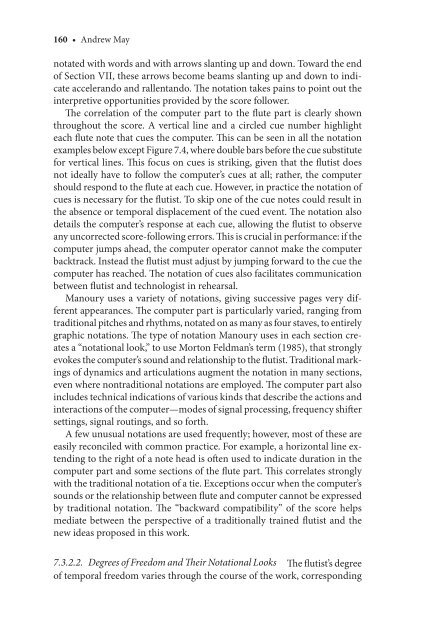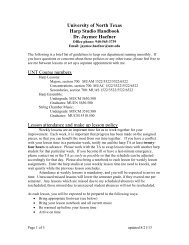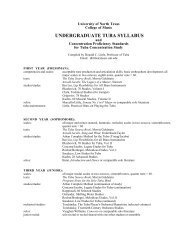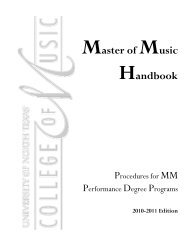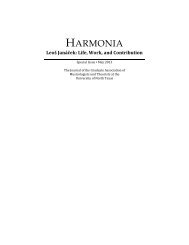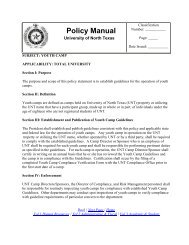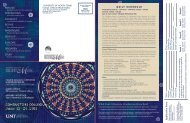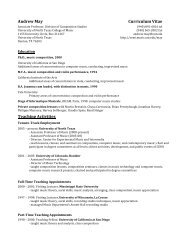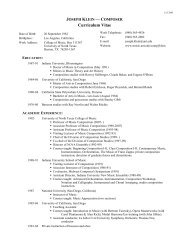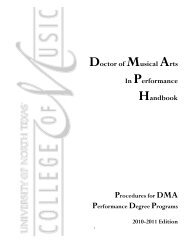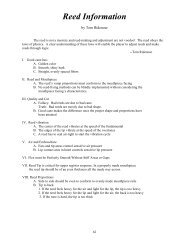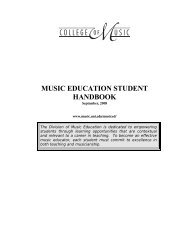7 Philippe Manoury's Jupiter1
7 Philippe Manoury's Jupiter1
7 Philippe Manoury's Jupiter1
You also want an ePaper? Increase the reach of your titles
YUMPU automatically turns print PDFs into web optimized ePapers that Google loves.
160 • Andrew May<br />
notated with words and with arrows slanting up and down. Toward the end<br />
of Section VII, these arrows become beams slanting up and down to indicate<br />
accelerando and rallentando. Th e notation takes pains to point out the<br />
interpretive opportunities provided by the score follower.<br />
Th e correlation of the computer part to the fl ute part is clearly shown<br />
throughout the score. A vertical line and a circled cue number highlight<br />
each fl ute note that cues the computer. Th is can be seen in all the notation<br />
examples below except Figure 7.4, where double bars before the cue substitute<br />
for vertical lines. Th is focus on cues is striking, given that the fl utist does<br />
not ideally have to follow the computer’s cues at all; rather, the computer<br />
should respond to the fl ute at each cue. However, in practice the notation of<br />
cues is necessary for the fl utist. To skip one of the cue notes could result in<br />
the absence or temporal displacement of the cued event. Th e notation also<br />
details the computer’s response at each cue, allowing the fl utist to observe<br />
any uncorrected score-following errors. Th is is crucial in performance: if the<br />
computer jumps ahead, the computer operator cannot make the computer<br />
backtrack. Instead the fl utist must adjust by jumping forward to the cue the<br />
computer has reached. Th e notation of cues also facilitates communication<br />
between fl utist and technologist in rehearsal.<br />
Manoury uses a variety of notations, giving successive pages very different<br />
appearances. Th e computer part is particularly varied, ranging from<br />
traditional pitches and rhythms, notated on as many as four staves, to entirely<br />
graphic notations. Th e type of notation Manoury uses in each section creates<br />
a “notational look,” to use Morton Feldman’s term (1985), that strongly<br />
evokes the computer’s sound and relationship to the fl utist. Traditional markings<br />
of dynamics and articulations augment the notation in many sections,<br />
even where nontraditional notations are employed. Th e computer part also<br />
includes technical indications of various kinds that describe the actions and<br />
interactions of the computer—modes of signal processing, frequency shift er<br />
settings, signal routings, and so forth.<br />
A few unusual notations are used frequently; however, most of these are<br />
easily reconciled with common practice. For example, a horizontal line extending<br />
to the right of a note head is oft en used to indicate duration in the<br />
computer part and some sections of the fl ute part. Th is correlates strongly<br />
with the traditional notation of a tie. Exceptions occur when the computer’s<br />
sounds or the relationship between fl ute and computer cannot be expressed<br />
by traditional notation. Th e “backward compatibility” of the score helps<br />
mediate between the perspective of a traditionally trained fl utist and the<br />
new ideas proposed in this work.<br />
7.3.2.2. Degrees of Freedom and Th eir Notational Looks Th e fl utist’s degree<br />
of temporal freedom varies through the course of the work, corresponding<br />
Simoni_RT76294_C007.indd 160 9/22/2005 11:19:20 AM


